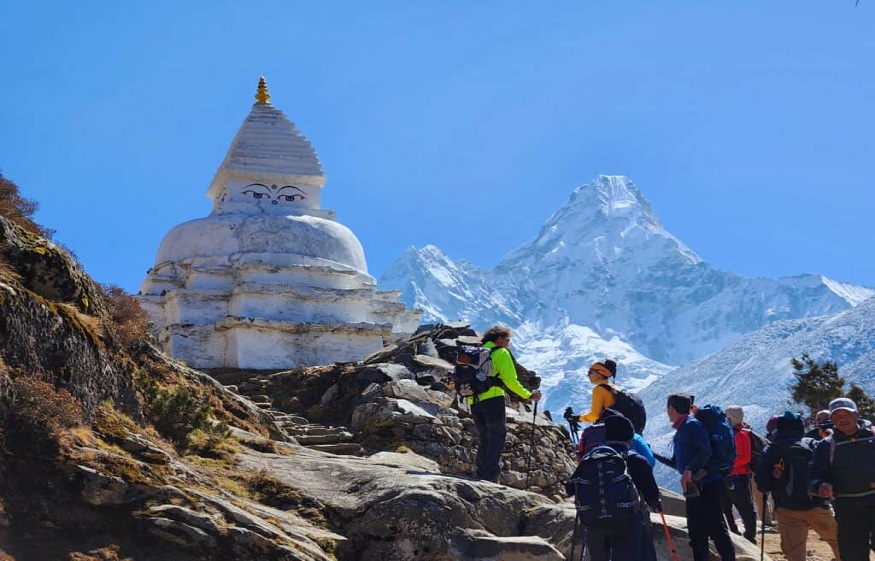
My EBC trip would not have been possible without the Sherpa at their best. From the second I set foot in the Khumbu, they made an already unbelievable trek into one that was truly humbling and awe-inspiring. Thanks to Sherpas and their extraordinary strength and knowledge, this would end in the test of the human spirit rather than the body.
Everest Base Camp Treks In the turbulence of landslides, lung-bursting altitudes, and moody weather, the Sherpas were an unshakeable foundation. They imparted their profound knowledge of the mountains, imparting an understanding of their culture, religion, and the sanctity of the Himalayas. The Sherpas’ profound connection to their homeland and their spiritual reverence for the peaks around us made every step feel meaningful, more important than just reaching the top.
Their ceaseless composure and optimism, despite cold, altitude sickness, and fatigue, were nothing short of inspiring. They were never in a hurry, they always made sure we were going slow to give our bodies time to acclimatize and to take in the beauty that was around us. Their words of encouragement when the trail became too much, their smiles when we were low, and their ability to read our necessities, sometimes without a word, were something no guide could provide.
The tough moments were also made bearable by the Sherpas. They stuck with us on tough ascents, when each breath seemed a labor, offering comfort, hot tea, and even jokes. But their muscle and stamina built through years of experience at high altitude were also a testament to the grit of the human spirit.
By the time we arrived at Everest Base Camp, it had clicked that the trek had all been about so much more than getting to a physical place. It had been about sharing thoughts, ideas, and reaching out to a community of amazing people, who were inspired by their knowledge and gave strength and wisdom through the deep connection between the mountains and those who live in them. The individuals who were to lead us to EBC, the Sherpas, did more than that — they turned a trek into one of the most profoundly spiritual and inspirational experiences of my life.
That introduction – A Ride Over the Mountain
The Everest Base Camp (EBC) trek is not just a grim test of your physical endurance; it is a transformative odyssey that transcends the monumental peaks of the majestic Himalayas. It’s a sojourn into the maw of the mountains, a profound examination of the limits of the human body, and a spiritual meeting with a nature that is uglier and rawer than most of humanity will ever grasp. The steep terrain, the increasingly thin air, and the spiritually-charged environment of the Khumbu region all challenge, but also reveal something deeper—strength within, peace, and the beauty of simplicity.
But the true adventure starts as soon as you touch the Sherpa hometown— the soul and spirit of this trek. Additionally, the trail to Everest Base Camp is more than just a walk to some random point; it’s a chance to absorb new and foreign cultures, to be at one with the land, to learn from the people who have always called this land their home. And the Sherpas, with limitless courage and humility and kindness, will show you every step along the way. In the tranquility of the mountains and the loyalty of the Sherpas, you will find much more than the summit — a glimpse of life that is based on respect for nature, community, and never, ever giving up.
This trip is about more than the mountains — it’s about the discovery of yourself.
Meeting the Sherpas: Initial Impressions
Meeting a Sherpa for the first time is often a humbling, inspiring experience. As you travel from the bustling town of Lukla deep into the Khumbu region, the Sherpas, generations of whom have lived in the shadow of Everest, act as the gatekeepers of the mountains. Their initial impressions tend to be so modest and yet so–not sure what’s the word–if not humble (as in, they do too good work to not feel confident), then certainly not showy.
Himalayan Base Camp Trek Sherpas are famed for their superhuman physical strength and ability to move nimbly up and down the steep, rocky terrain. But it’s not just their power — it’s their warmth, their kindness. They smile with their heart, and they give till it hurts. Whether it is giving you a helping hand across a difficult section of the trail or a cup of hot tea on a cold night, Sherpas will protect and care for you.
Deprived as they are of comfort in their hard lives of mountain-soldiery, they know no want. Sherpas exude an unassuming confidence that they will be able to survive in such extreme conditions. It is this first impression that, if the guides are successful, is carried away on the rest of the trek: a sense of being at peace, secure, foot-off-the-ground respect for the world around resounds long after the words thank you are exchanged and the trek has ended.
Led by Wisdom and Foresight
And there is much, much more to sherpas than simply leading; they are the spirit of the expedition and bring a knowledge and experience of mountains acquired over a lifetime. Their intimate knowledge of the landscape, the weather, and the trails around Everest makes them priceless companions for any trekker. Their knowledge is not just academic: It arises from generation upon generation of surviving and thriving in one of the harshest and most unforgiving climates on the face of the Earth.
Everest Base camps As you trek, you soon realize how much the Sherpas know, not only about the land but the trail itself. They know the nuances of weather patterns, the telltale signs that a storm is on the way, and the best way to walk down a tricky hill or slide around an icy corner on the trail. This wisdom is an open secret, handed down from one generation to the next, and it’s what guarantees a safe, successful trek.
But their wisdom is not just physical. Sherpas, too, are acutely aware of the mental and psychological struggles trekkers experience. They knew how to push and nudge, to whisper reassurances when exhaustion and altitude sickness loomed large. Their cool head and reassuring presence are confidence-inspiring in an otherwise challenging environment. In a lot of ways, they lead not only through the mountains, but through your path, too.
Acts of Kindness on the Trail
The kindest, most giving part of the Everest Base Camp trek is the sherpa people. No matter how tough the trek, Sherpas are ever willing to lend a hand, share a word of support, or provide a hearty comfort meal. The mountains are unforgiving, but the warmth of Sherpa hospitality is unceasing; a juxtaposition of brutal trail conditions versus the level of hospitality displayed on route.
From Day 1, Sherpas will greet you with smiles, heavy loads on their backs, and advice on how to cope with the punishing conditions. They will drop everything to help a trekker out, if they don’t help a trekker across a rickety bridge, help readjust a rucksack, or give you information on the trail a few hours ahead. They have a built-in sense of what each individual requires, and they’re there, supporting quietly, without the need for recognition.
Such little, modest acts of generosity translate into a sense of collegiality and confidence. The kindness of the Sherpas makes for trekkers who feel looked after and inspired to keep on walking. Travelling through the villages and camps, the selfless acts of kindness you witness along the trail are what you will remember as the greatest parts of the adventure; evidence that in the harshest of places, humanity and having kindness for your fellow man/woman is the thing that stands out most.
Learning Simplicity’s Strength
The Everest Base Camp trek cost is as much of a mental journey as a physical one, and a crash course in simplicity. The Sherpas are residents of some of the most isolated corners of the planet, so they really know how to live with less and enjoy more. Their existence is marked by the community, their religion, and the land. In a culture that undoubtedly places material success and outward achievements above all else, it is the Sherpas who teach us that true strength comes from living lives of purpose, humility, and connection to the earth.
After hiking these mountains, you discover how much you can learn from the Sherpas’ example in life. They carry more weight than anyone else, and they do so not because they are stronger than the rest of us but precisely because they are not, and they have learned from a multitude of tiny carryings not to take on more than they can bear. They care for their health and community over digital stimuli for our age, which means that strength is in the awareness of my purpose and grounding in the present.
And the minimalism of their lifestyle translates to their relationship, too. There is no hurry, no requirement of more than is necessary. They teach you to walk it one step at a time, to take comfort in the little everyday victories, and to be mindful of the peace that comes from living with intention. By the end of the journey, you understand that the real power is not to reach the top—it is to walk the path with humility, patience, and simplicity.”
Stories Shared Around the Fire
Some of my fondest memories on the way Trek To Base Camp Mount Everest were the stories told sitting around the fire, one story. We’d be tired and cold from days of hiking at elevation, finally winding down in the warmth of the teahouse with Sherpas, guides, and trekkers. The fire popped, and its warmth was a welcome contrast to the chill outside, but it was the stories of home that soothed the soul. And the Sherpas, the revered people of the Himalayas, would tell stories of their forefathers, of their bond with the taming mountains, and of the struggles climbers had endured through the years. These were more than just entertaining stories, they were lessons in steadfastness, tenacity, and modesty. They also talked about the profound spiritual meaning of the mountains and the sacred purpose Sherpas serve in keeping people safe as they travel through their snowcapped beauties. Every night, the circle of stories became smaller and more intimate, the revelry more intense. Listening to stories shared by the Sherpas themselves, it was obvious that the mountains were not only a place of physical challenge, but a place of spiritual gain and connection. The fire and the stories and the shared experience created a bond that bridged nationalities and backgrounds. And it was in these moments of stasis — in the warmth of fire and friends —that we witnessed the trek and its way of life. More than a journey to Everest Base Camp was an opportunity to connect on a deeper level, both with the land and the extraordinary people who call it their home.
Facing Challenges Together
The Everest Base Camp hike is no walk in the park, and you may find yourself facing physical and emotional challenges on your hike. But one thing that struck me was how much easier it was when we confronted those challenges together, with the help of the Sherpas. From tips on uphill ascents to coping with the challenges of high-altitude hiking, the Sherpas were there every step of the way, providing advice, encouragement, and a sense of camaraderie. Whether it was a tough patch on the trail or the time your altitude sickness is getting the best of you, we never felt alone. They got it about pacing and would stop at intervals to make sure we were acclimatizing properly. The experience was even more striking because of the teamwork involved. We were all in this, and it was the motivation of our peers that helped us stand up at times when all we wanted to do was give up. We rallied each other on, celebrated small victories, and supported each other when it felt like the ride was getting too tough. With their calm steadiness and steadfast support, the Sherpas taught us that confronting challenges isn’t just about physical strength — it’s about community, shared determination. The adventure wasn’t just about getting to Everest Base Camp; it was about developing resilience together. Together, the battles seemed less daunting, and every moment of adversity brought us closer. By the time we finished the trek, I learned that it wasn’t the summit we attained that was most important — it was the people we did it with.
The Sherpa Spirit: A Quiet in the Storm
The Sherpa way is truly something special. The thing that stood out to me throughout the entire trek to Everest Base Camp was the silence and total calm of the Sherpas. Despite the challenging physical hardships of the hike and the unpredictable weather, the Sherpas had a calming presence that put many of us at peace. They are masters not only of treading the treacherous landscape but also of encouraging trekkers through the mental and emotional storms that can come with such an effort. When the weather would change, or when altitude sickness began to take its toll on trekkers, the Sherpas’ composure was always a source of much-needed comfort. They didn’t panic. They programatically diagnosed the situation, offered rational advice, and gave us strength. The confidence and strength were infectious, so that the journey is not only getting there, it’s being strong and determined. The Sherpas, the rest of the Himalayan world would bear witness, were at their best when the ground opened beneath them. They were not just our guides — they were living examples of resilience in the face of pressure and grace under pressure. Their ability to handle adversity with composure and optimism has been something that I took from them. In a place that can seem unyielding in terms of elements and terrain, the Sherpas are a testament that power comes from being calm and having a strong heart. They showed me that, however steep the summit, inner peace is every drop of the essential oil in taming the wildest storm.
Arriving in EBC on Sherpa Gentlemen’s Assistance
Reaching Everest Base Camp Trek is the result of an amazing journey that I was only able to make thanks to the help of the Sherpas. They were the heart and soul of the whole adventure, guiding us through sometimes treacherous terrain, lifting us on cloudy days when the miles seemed endless, and keeping us safe every step of the way. The EBC Trek is a tough grind; it is long, physically challenging, and offers up some tough challenges. But with the Sherpas at our side, every one of these barriers seemed a bit more surmountable. They were familiar with the landscape and could predict conditions, which allowed us to adjust gear, pace, and expectations accordingly. They were more than just guides; they were our friends, cheering each progress, congratulating each achievements, and helping us through every challenge. And when we finally made it to EBC, standing before the world’s tallest summit, it felt like we had all won something together. This was only made possible by the support of the Sherpas, and I realized with a deep sense of thankfulness that the trek wasn’t only about arriving at the destination, but it was about the journey and the people who made it possible. Their professionalism, expertise, attitude, and friendliness changed what may have been a lonely personal journey into something we experienced together, and reaching Everest Base Camp felt like a mutual success. All of those heroes are an incredible reminder that no great thing is accomplished alone, and the Sherpas were so important in making this dream come true.
A Life Transformed by Their Humility and Heart
There was something about the Sherpas I met on my pilgrimage to Everest Base Camp that continues to inspire me – not only their knowledge and their strength, but their humility and their heart. Even though they have to encounter the hard conditions daily, they have never flexed their skills or experience. Instead, they displayed such quiet dignity and selflessness that was very humbling. They were generous in ways that went beyond just their physical donations; they gave of their lives, their culture, and their stories in a way that made us feel like we were all family. It was from their personal generosity and lack of guardedness that I first came to realize what triumph is — not merely surviving such physical deprivation (of course not only that), but the capacity to stay kind, sane, and happy, even in the face of life’s vicissitudes. The Sherpas Coexist with the Mountains, and It Shows Throughout Their Lives. All of this is evidence of the Sherpas’ profound spiritual relationship to their environment. Of course, they are strong, one of the finest climbers in the world, and they have probably seen it all~ Yet their modesty made quite an impression. The fact that they treated everyone, regardless of levels of skateboarding talent and country of origin, with respect showed me that real strength isn’t about dominating, but in quietly and consistently working to support and elevate one another. When I left the mountains, I took with me the humility, patience, and gentleness that the experiences with the Sherpa people demonstrated so effortlessly. Their hearts, more than their strength, sent me on a life journey I’ll never forget and do not regret.
Why are Sherpas helpful in climbing Mt Everest?
Sherpas are integral to ascending Mount Everest, and the knowledge they bring is frequently the main factor in determining success or failure for an expedition. The Sherpas are from the high mountains of Nepal, they are born to live in the hard conditions of the Himalayas. “They are ideal guides and support staff because they are highly adapted to the thin air and harsh environment. Sherpas help ferry heavy loads, establish camp, and navigate hazardous terrain. They are also taught mountaineering techniques, including fixing lines, erecting ladders, and creating a safe path through the crevasses of the perilous Khumbu Icefall and other high-altitude threats. They are also the people most familiar with the mountain, its weather, and their experience gives them the best insight into how to help climbers avoid altitude sickness and safely guide them to and from the summit. They do a good job of reading the mountain’s heart and recognizing when conditions are too treacherous to go on, and they save lives. Sherpas also provide some psychological services on the ascent, sharing words of encouragement, offering moral support throughout the journey. Indeed, without the Sherpas’ skill and loyalty, most of the successful summit climbs would have been far beyond reach. Their advances have made them indispensable in high-altitude mountaineering, the unsung heroes of Everest (and other Himalayan) expeditions.
What is so special about Everest Base Camp?
Everest Base Camp Treks Climbing/High Altitude Category: Everest is not only a physical location; it is a spiritual and emotional achievement for trekkers and mountaineers. EBC is located at a height of 5,364 meters, or 17,598 feet, and is the gateway to the world’s highest mountain, Mount Everest. What makes EBC particularly memorable is not only the sense of accomplishment you feel getting to such a high and remote place, but also just the breathtaking panoramic views and the rich cultural experiences along the way. The way to EBC meanders through charming Sherpa villages, green forests, and extensive glaciers, granting trekkers a taste of what it feels like to be in the heart of the Himalayas. The colorful prayer flags, which are eye-catching as they flap in the breeze, contrast softly against the white hue of the stupas and contribute to the spiritual atmosphere. You pass each day, the terrain changes, becoming rougher and untamed, huge peaks and the stunning Khumbu Icefall now in sight as you near the base camp. The camp itself is a surging metropolis of climbers, Sherpas, and trekkers with their dreams of scaling the mountain. EBC is a unique opportunity to be at the foot of Everest and not only see what nature can do but also what men can overcome. It is a site of shared history, where countless expeditions have set out to ascend the top of the world, and it provides trekkers with a feeling of being connected to something a lot more than they are. And really, it’s a once-in-a-lifetime experience, very satisfying not only physically but spiritually.
Why are the Sherpas very famous?
The Sherpas have become famous throughout the world for their skill and expertise in high-altitude mountaineering; they are best known for their support of high-altitude climbing in the Himalayas. Their extraordinary ability, power, and instincts for surviving in pressure-filled situations have made them critical to any climber’s chances of reaching the summit of Mount Everest. Sherpas, who are originally from the Khumbu region of Nepal, have, over generations, become adapted to the harsh high-altitude environment of the Himalayas, where low oxygen and extreme weather are the usual. Their ability to adapt naturally to high altitudes enables them to carry out many feats others would find quite strenuous. The Sherpas are not mere manual laborers — they are very skillful mountaineers, adept in rope work, ice climbing, and other technical aspects of mountaineering. Several Sherpas have climbed Everest several times, making them among the most skillful climbers in the world. Part of the legend of Sherpas is that they are great climbers and great people – they’re humble, gracious, and they make the best tea. They have been crucial in directing expeditions, ferrying supplies, and keeping climbers safe. The most well-known Sherpa, Tenzing Norgay, and Sir Edmund Hillary were the first people to reach the top of Mount Everest in 1953. Since then, Sherpas have been synonymous with mountain climbing, and their work has been vital to the success of innumerable Everest expeditions. Their strength, resilience, and selflessness have gained them international respect and admiration, putting the Sherpa name on the map as a force to be reckoned with.
What was the experience of the Everest Base Camp Trek?
The Everest Base Camp trek, one of the most life-altering moments for me. It wasn’t just about getting to a place physically, but also about getting in touch and connecting with oneself, traveling out and traveling in.” The journey is about 12 days long and brings you into the heart of the Khumbu region in Nepal. Every step of this amazing place opens you up to jaw-dropping views of tall peaks, glaciers, and valleys. The trails are festooned with prayer flags flapping in the wind, imparting a spiritual quality to the hike. En route, you trek through colorful Sherpa villages like Namche Bazaar and Tengboche, rich in Buddhist culture. The villages are located under the eyes of the grand Everest, and you get to know about the spirituality and beliefs of the villagers who are in intimate touch with the mountains and the far country. Among the greatest challenges, he said, was the high-altitude environment. As we climbed, the thin air made every step more strenuous, and rest days to acclimate were essential to adjust to the altitude. But the help of the Sherpas, who stayed with us, calming and coaxing, made it easier. They gave encouragement, adapted the speed, and offered an encouraging word when things got hard. When we finally got to Everest Base Camp, I felt a sense of shared victory, by far the best feeling that I had made it, but that we all had made it. It gave me such an incredible sense of achievement, along with the staggering beauty of the environment. The trek taught me a lot about the strength of persistence, the importance of community, and how deeply we can connect to nature.

 Difference Between a Savings Account & Current Account
Difference Between a Savings Account & Current Account  How Loan Terms Differ Between Car Loans and Motorcycle Loans
How Loan Terms Differ Between Car Loans and Motorcycle Loans  Growing Small Businesses with Virtual Assistant Services
Growing Small Businesses with Virtual Assistant Services  How to Find the Right Engagement Ring Style for You at Lily Arkwright
How to Find the Right Engagement Ring Style for You at Lily Arkwright 
